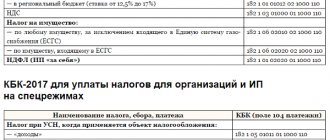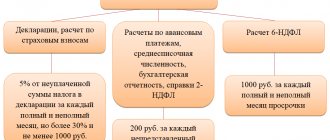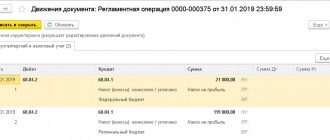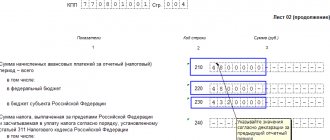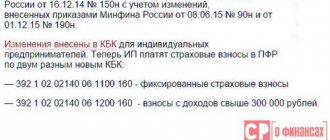Tax legislation provides for an investment deduction for income tax. Regions that have adopted the relevant law for 2020 are the place where you can reduce your income tax on such a deduction. The list of subjects is in the article.
Also see
- Changes in income tax 2020
- All changes to the Tax Code of the Russian Federation since 2020.
Available in NK
The Tax Code allows a one-time reduction of income tax and advance payments for this tax due to the costs of acquiring or constructing fixed assets and the costs of their reconstruction, modernization, completion or additional equipment. This is an investment tax deduction (Article 286.1 of the Tax Code of the Russian Federation).
It cannot be applied throughout the country. Regions in which investment income tax deductions can be applied have made corresponding changes to their legislation.
Restoring INV
In the event of the sale (other disposal) of an asset (other than liquidation) in respect of which an INV was applied, if the useful life of this fixed asset has not yet expired, the organization will be obliged to transfer to the budget the part of the NP that was not previously paid in addition to the amount of the deduction, and additionally pay penalties.
The amount of penalties is calculated starting from the day following the deadline established by the Tax Code of the Russian Federation for the payment of income tax.
Please note: we are not talking about advance payments of tax, but about NP that is subject to payment to the budget after the expiration of the tax period.
Khanty-Mansiysk Autonomous Okrug
In this entity, deductions are possible for expenses on fixed assets of the third to seventh depreciation groups. The deduction includes expenses from paragraph 2 of paragraph 1 and paragraph 2 of Article 257 of the Tax Code, except for liquidation expenses.
The deduction can be applied by organizations that are engaged in the following types of activities:
- crop and livestock farming, hunting and the provision of related services in these areas;
- forestry and logging;
- fishing and fish farming;
- manufacturing industries, except for the separation and extraction of fractions from petroleum (associated) gas;
- water collection, purification and distribution;
- wastewater collection and treatment;
- collection, processing and disposal of waste
The relevant norms are contained in Article 2.1 of the Law of the Khanty-Mansiysk Autonomous Okrug - Ugra dated September 30, 2011 No. 87-OZ.
Karelia
The deduction is applied to expenses on fixed assets of the third to seventh depreciation groups. It includes expenses from paragraph 2 of paragraph 1 and paragraph 2 of Article 257 of the Tax Code, except for liquidation expenses.
The deduction has the right to apply to organizations that are engaged in the following types of activities (Article 12.1 of the Law of the Republic of Karelia dated December 30, 1999 No. 384-ZRK):
- production of biologically active food additives;
- production of medicines and materials used for medical purposes
Where does the deduction already apply?
The Parliament of Karelia was the first to allow the use of an investment tax deduction, having adopted Law No. 2225 of 04/04/2018 - ZRK, aimed at increasing the investment attractiveness of a constituent entity of the Russian Federation.
Starting from January 1, 2020, organizations are entitled to a deduction in respect of fixed assets acquired for:
- manufacturing of dietary supplements and medications;
- manufacture/purchase of medical devices responsible for the manufacture of medicines;
- for other medical purposes.
In accordance with these goals, the income tax of Karelia organizations can be reduced from 17% to 8.5%.
Other regions are also expected to adopt corresponding laws. Whether you can reduce the profit on current operating expenses, check with your tax office or on the official website of the Federal Tax Service of Russia on the pages of the regional Federal Tax Service.
Amur region
| Deductions are possible for expenses on fixed assets of the third to seventh depreciation groups. The deduction includes expenses from paragraph 2 of paragraph 1 and paragraph 2 of Article 257 of the Tax Code, except for liquidation expenses. Organizations that simultaneously meet two conditions can apply the deduction:
| 5 percent |
See Article 1.1 of the Law of the Amur Region dated 04.10.2010 No. 389-OZ.
Vologda Region
Organizations that are included in the list of priority investment projects have the right to apply the deduction (Procedure approved by Decree of the Government of the Vologda Region dated October 28, 2013 No. 1114). An exception is organizations that apply a reduced tax rate under Article 1 of the Law of the Vologda Region dated April 30, 2002 No. 781-OZ.
If the organization's expenses exceed the deduction limit, they can be taken into account during five subsequent tax periods from the date when:
- the facility was put into operation;
- changed the initial cost of the object
Such rules are established by Article 5 of the Law of the Vologda Region dated April 30, 2002 No. 781-OZ.
When is INV used?
INV is applied to the tax calculated for the tax (reporting period) in which:
- the corresponding OS object has been put into operation;
- the initial cost of the object has been changed as a result of completion, additional equipment, etc.
According to the wording of the law, if the INV cannot be applied in full during the period of putting the facility into operation (due to the INV exceeding its maximum value), this can be done in subsequent periods. Moreover, the constituent entities of the Russian Federation are given the right to prohibit such transfer of INV.
Jewish Autonomous Region
Deduction for expenses on fixed assets of the third to seventh depreciation groups. The deduction includes expenses from paragraph 2 of paragraph 1 and paragraph 2 of Article 257 of the Tax Code, except for liquidation expenses.
The deduction is entitled to apply to organizations that are engaged in the following types of activities (Article 1 of the Law of the Jewish Autonomous Region dated December 17, 2008 No. 490-OZ):
- manufacturing industries;
- activities of sanatorium and resort organizations;
- water collection, purification and distribution;
- wastewater collection and treatment
Kaluga region
Deductions are possible for expenses on fixed assets of the third to seventh depreciation groups, except for cars. The deduction includes expenses from paragraph 2 of paragraph 1 and paragraph 2 of Article 257 of the Tax Code, except for liquidation expenses.
Organizations that are included in the register of programs for updating and modernizing fixed assets of enterprises have the right to apply the deduction.
If the organization’s expenses at the end of the year exceeded the deduction limit, they can be taken into account during three subsequent tax periods (Article 5.5 of the Law of the Kaluga Region dated December 29, 2009 No. 621-OZ). We continue to list in which regions an investment tax deduction for income tax has been introduced.
Powers of the regions under Art. 286.1 Tax Code of the Russian Federation
Regional authorities have broad powers regarding IW. A company will be able to use IW if:
- in the region where it is located, a law establishing the right to IW has been adopted;
- the company is not included in the category of taxpayers in respect of whom the right to IP is limited in this law (if there are such restrictions).
In addition, regional authorities are given the opportunity to:
- specify the categories of fixed assets in respect of which IW is provided or not provided;
- approve your IW value (within the framework of the norms established in Article 286.1 of the Tax Code of the Russian Federation);
- prohibit or allow the transfer of the balance of the investment income to subsequent tax periods;
- set other conditions and restrictions (for example, the length of the period after which you can use IW again after abandoning it).
When regional laws may affect taxpayer responsibilities and/or tax liabilities, find out here.
IW is not available to certain categories of taxpayers, regardless of regional legislation. The “prohibitive” list is specified in paragraph 11 of Art. 286.1 Tax Code of the Russian Federation. If you find yourself in it, you don’t have to bother studying the regional law on IP - you are deprived of the right to deduction. Find out who is on this list below.
Yamalo-Nenets Autonomous Okrug
The deduction applies only to structures “220.00.00.00.000 STRUCTURES” (OK 013-2014), which were created as part of investment projects. The deduction applies to expenses from paragraph 2 of paragraph 1 and paragraph 2 of Article 257 of the Tax Code, except for liquidation expenses.
The deduction is entitled to apply to organizations that extract high-viscosity oil from oil rims of oil and gas deposits, where the oil in the sub-gas zones is underlain by bottom water.
The total deduction amount cannot exceed 10 percent of the total cost of the investment project. If at the end of the year expenses exceed the deduction limit, they can be taken into account during three subsequent tax periods.
See Article 1.1 of the Law of the Yamalo-Nenets Autonomous Okrug dated September 25, 2008 No. 77-ZAO.
The mechanism for applying the deduction
Immediately after the tax period, the entire calculation is actually performed anew each time, since the amount of tax (advance payments) is considered a cumulative total.
Step 1. Determine the amount of expenses included in the deduction
This amount will be equal to the amount of expenses for acquisition (construction, etc.) and (or) modernization (reconstruction), etc. fixed assets in respect of which INV can be used for the reporting (tax) period. In what follows, we will call this amount the “amount of investment expenses.”
Step 2. Determine the amount that applies to the reduction of “federal” income tax
This amount is 10% of the expenses determined in step 1, but not more than the amount of tax payable to the federal budget. The difference between the amount by which income tax is actually reduced and 10% of the amount of investment expenses cannot be used in subsequent tax periods.
For example, the amount of investment expenses of the organization for 2020 amounted to 3 million rubles. At the end of the year, the tax payable to the federal budget was determined in the amount of 270 thousand rubles. In this case, the amount of the deduction that reduces the tax in the “federal” part will be only 270 thousand rubles. A deduction in the amount of 30 thousand rubles (3 million rubles × 10% - 270 thousand rubles) cannot be used; these expenses will “disappear” for income tax.
Step 3. Determine the maximum deduction amount for the “regional” income tax
For income tax payable to the budget of a constituent entity of the Russian Federation, the maximum deduction amount is determined as follows:
| Limit value of deduction (MPV) | = | Tax at the rate established by the Tax Code of the Russian Federation | – | Tax at 5% rate |
Note that a subject of the Russian Federation, when introducing an investment tax deduction, can establish a different (different from 5%) tax rate for calculating the maximum deduction amount.
Step 4. Determine the amount of deduction that applies to reducing the “regional” income tax
The amount that reduces the tax payable to the budget of a constituent entity of the Russian Federation is 90% of the amount of investment expenses. The deduction amount (in the “regional” part) transferred from previous periods is also added to this value. In this case, the tax can be reduced by no more than PPV.
For example, the amount of investment expenses of the organization for 2020 amounted to 5 million rubles. At the end of the year, the tax base amounted to 30 million rubles, PIT = 30 million rubles × 17% – 30 million rubles × 5% = 3.6 million rubles. The “regional part” of the INV will amount to 90% of investment expenses, that is, 5 million rubles × 90% = 4.5 million rubles.
This means that in 2020, the amount of tax payable to the budget of a constituent entity of the Russian Federation will be reduced by 3.6 million rubles and will amount to 1.5 million rubles (30 million rubles × 17% - 3.6 million rubles). The balance of the “regional deduction” in the amount of 4.5 – 3.6 = 0.9 (RUB million) can be transferred to 2020 and subsequent years of application of the deduction.
Calculation example
In October 2020, Beta LLC acquired and put into operation a production line (4th depreciation group) worth 15,000 thousand rubles. Its useful life is 61 months. In February 2019, a machine worth 2,500 thousand rubles was purchased. Its useful life is also 61 months. There were no other investment expenses in 2020 and in the first quarter of 2020.
In the constituent entity of the Russian Federation in which Beta LLC is registered, a law has been passed allowing the use of investment tax deductions. The maximum deduction amount (for “regional” tax) is calculated using a rate of 5%. The Company calculates monthly advance payments based on the actual profit received.
The tax base is determined by the organization in the following amounts:
- for January - September 2020 - 43,000 thousand rubles;
- for January - October 2020 - 46,000 thousand rubles;
- for January - November 2020 - 51,000 thousand ₽;
- for 2020 as a whole - 58,000 thousand rubles;
- for January 2020 - 2,000 thousand rubles;
- for January - February 2020 - 16,000 thousand rubles;
- for January - March 2020 - 23,000 thousand rubles.
The calculation of the amount of investment expenses that reduce tax (advance payments) and the amount of tax (advance payments) payable in each of its parts for the named periods is given in tables 1 and 2.
Table 1. Tax base, tax amounts and investment expenses, thousand rubles
Table 2. Calculation of tax-reducing expenses (advance payments) and tax amounts (advance payments) payable, thousand rubles
Let's give a brief explanation.
There were no investment expenses for the period January - September 2020 This means that the amounts of advance payments (cumulative total) for the period will be, respectively, 1,290 thousand rubles (43,000 thousand rubles × 3%) to the federal budget and 7,310 thousand rubles (43,000 thousand rubles × 17% ) to the budget of a constituent entity of the Russian Federation.
During the period January - October 2020, investment expenses in the amount of 15,000 thousand rubles were made. Of these, the tax payable to the federal budget can be reduced by 1,500 thousand rubles, and the tax payable to the budget of a constituent entity of the Russian Federation by 13,500 thousand rubles. In fact, the tax is reduced only in an amount not exceeding the maximum amount.
Thus, the tax (advance payment) payable to the federal budget at the end of 10 months of 2020 is reduced by 1,380 thousand rubles - to zero. All advance payments previously paid in 2020 become overpaid (and can be returned or offset in the general manner). Expenses in the amount of 120 thousand rubles in this reporting period cannot be used to reduce federal tax.
The tax (advance payment) payable to the regional budget, based on the results of 10 months of 2020, is reduced by 5,520 thousand rubles and will amount to 2,300 thousand rubles. Expenses in the amount of 7,980 thousand rubles remain unused.
For the period January – November 2018, the amount of investment expenses does not change, but the tax base increases, and therefore the possible amount of tax reduction (advance payments). Based on the results of this reporting period, expenses in the “federal” part will be used in full - in the amount of 1,500 thousand rubles, and the tax (advance payment) payable to the federal budget will be 30 thousand rubles (1,530 thousand rubles - 1,500 thousand ₽). The tax (advance payment) to the regional budget will decrease by 6,120 thousand rubles and amount to 2,550 thousand rubles (8,670 thousand rubles – 6,120 thousand rubles).
For 2020, in general, the amount of investment expenses remains the same, but the amount of reduction in the “regional” tax increases (investment expenses in the federal part have already been fully used). At the end of the year (tax period), the tax payable to the federal budget will be 240 thousand rubles (1,740 thousand rubles – 1,500 thousand rubles). The tax to the regional budget will decrease by 6,960 thousand rubles and amount to 2,900 thousand rubles (9,860 thousand rubles – 6,960 thousand rubles). The amount of investment expenses not used in 2020 in the amount of 6,540 thousand rubles (13,500 thousand rubles - 6,960 thousand rubles) is carried over to the following tax periods.
For the first reporting period (January) 2020, Beta LLC had no investment expenses. Therefore, the tax (advance payment) to the federal budget must be paid in the full calculated amount - 60 thousand rubles. But in the regional part, the advance payment can be reduced by investment expenses carried over from last year, but again no more than to the minimum amount determined by law. Thus, the “regional” tax (advance payment) is reduced by 240 thousand rubles and amounts to 100 thousand rubles.
During the period January - February 2020, investment expenses in the amount of 2,500 thousand rubles were made. Therefore, the “federal” advance payment is reduced by 250 thousand rubles and amounts to 230 thousand rubles (in the “federal” part, investment expenses will be used in full). The “regional” advance payment is reduced by 1,920 thousand rubles and amounts to 800 thousand rubles, while it will not be possible to use the expenses carried over from last year for this reporting period as a whole (since the tax is calculated on an accrual basis).
In this situation, another logic is possible (we marked these values with * in the table). Since part of the “transferred” expenses was already used in the previous reporting period, there is no reason to reduce this used part. However, in this case, the amount of expenses of the current period that reduce the tax (advance payment) will decrease by the same amount, that is, the amount of tax (advance payment) payable in any case will not be less than 5% of the tax base, and the unused amount will still be transferred for the future. In other words, the final result for any version of the reasoning will be the same, only the distribution of the used deduction between specific fixed assets, which is important for the early disposal of fixed assets, will be different.
The specific procedure for using investment expenses must be determined in the accounting policy for tax purposes.
Nevertheless, it seems that the more correct option is the one reflected in the table: by analogy with the transfer of losses to the future, all investment expenses of the current period are first used, and only then the remainder of the deduction carried forward from previous years.
For the period January - March 2020, the amount of investment expenses does not change, but the amount of the “regional” tax reduction also increases. The advance payment payable to the federal budget will be 440 thousand rubles (690 thousand rubles – 250 thousand rubles). Expenses accepted to reduce the “regional” advance payment will amount to 2,760 thousand rubles, including 2,250 thousand rubles of expenses of the current period and 510 thousand rubles from the amount transferred from 2018. Thus, the advance payment payable to the budget of the constituent entity of the Russian Federation at the end of the reporting period will amount to 1,150 thousand rubles.
Sverdlovsk region
Organizations with the status of a participant in a regional investment project in the field of tourism have the right to apply a deduction for expenses on fixed assets (Law of the Sverdlovsk Region dated December 31, 1999 No. 51-OZ), if (Article 4-5 of the Law of the Sverdlovsk Region dated December 6, 2018 No. 145-OZ ):
- the share of income from the types of activities specified in paragraph 2 of Article 4 of the Law of the Sverdlovsk Region dated December 6, 2018 No. 145-OZ, based on the results of the previous tax period, is at least 70 percent of the total amount of income;
- there are no debts on taxes, fees and insurance premiums for the period of provision of the deduction;
- fixed assets were created or acquired as part of a regional investment project, but not as a result of reorganization or from interdependent (affiliated) persons
On the application of investment tax deduction for income tax
In its letter, the Ministry of Finance explained some of the intricacies of using the investment income tax deduction.
If a company decides to take advantage of the investment tax deduction for income tax, then it can no longer apply both the investment deduction and depreciation to the same fixed assets. You can use the investment tax deduction or refuse it only starting from the next tax period for income tax. At the same time, you need to remember: if you decide to use the deduction, you can refuse it only after three years. And if you refuse to apply the deduction, then a new right to receive a deduction can only be obtained after three years. But even if you refuse the deduction, the right to depreciation of the fixed assets cannot be returned.
Investment tax deduction – what is it?
Let us recall that the investment tax deduction represents the cost of acquiring fixed assets and also the costs of completion, additional equipment, reconstruction, modernization and technical re-equipment of fixed assets. It reduces not the tax base for income tax, but the calculated tax itself. You can reduce the tax, which is transferred both to the federal budget and to the budgets of the constituent entities of the Russian Federation.
A company can apply a deduction both at the registration address of the head office and at the address of its separate divisions, branches and representative offices (clause 1 of Article 286.1 of the Tax Code of the Russian Federation).
The right to use the investment deduction for income tax is established by the constituent entities of the Russian Federation.
Conditions for investment deduction
To apply an investment deduction for income tax, the following conditions must be met:
- in the region where the company or its separate division is located, a law has been passed establishing an investment tax deduction (clause 6 of Article 286.1 of the Tax Code of the Russian Federation);
- the company commissioned fixed assets;
- for objects already put into operation, their cost was changed as a result of completion, additional equipment, reconstruction, modernization, technical re-equipment;
- the above objects belong to III-VII depreciation groups, i.e. their useful life is from over 3 to 20 years inclusive (paragraph 1, clause 8, article 286.1 of the Tax Code of the Russian Federation);
- the above items are taken into account on the balance sheet of the company itself or its separate division located in a constituent entity of the Russian Federation, where the law on investment deduction was adopted (clauses 4, 5 of Article 286.1 of the Tax Code of the Russian Federation);
- The company's tax accounting policy enshrines the decision to use the right to apply an investment tax deduction (clause 8 of Article 286.1 of the Tax Code of the Russian Federation).
Example 1. When can you use the investment deduction?
Taiga LLC and Skazka LLC plan to invest large sums in property in 2019. In the regions where they are located, laws have been adopted on the introduction of investment tax deductions. Taiga LLC is buying a road tractor for semi-trailers, Skazka LLC is buying a cargo-passenger lift. “Taiga” operates under the general taxation regime, “Skazka” – under the simplified taxation system.
Only Taiga LLC has the right to take advantage of the investment tax deduction for income tax: it is an income tax payer, and the acquired property belongs to depreciation group IV with a useful life of 5 to 7 years.
Skazka LLC does not have the right to use an investment tax deduction: it is not a profit tax payer, and the property belongs to depreciation group 2 with a useful life of 2 to 3 years.
The Ministry of Finance reminded that if an organization decides to use an investment deduction for fixed assets, depreciation on them cannot be written off as expenses. It will not be possible to take into account through depreciation the costs of reconstruction, modernization and other improvements to fixed assets.
Also, bonus depreciation cannot be included in current expenses.
Limitations when calculating investment deduction
The investment tax deduction reduces the income tax credited to the budget of the constituent entity of the Russian Federation and the federal budget.
The maximum amount by which the regional tax can be reduced is 90% of the costs of purchasing fixed assets or costs of modernization, reconstruction and other improvements to the fixed assets.
When reducing the regional tax by investment deduction, the minimum tax that must be paid to the budget is 5% of the tax base for income tax.
The amount of tax by which the federal tax can be reduced is 10% of the costs of purchasing fixed assets, as well as expenses for modernization, reconstruction and other improvements to the fixed assets. There is no minimum tax that must be paid to the federal budget. That is, as a result of applying the investment tax deduction, federal tax can be reduced to zero.
Let's look at how to calculate the investment deduction.
Example 2. When can you reduce income tax?
In its accounting policy for 2020, the company provided for the right to apply an investment tax deduction. The law of a constituent entity of the Russian Federation establishes general rules for the application of investment tax deductions in accordance with Article 286.1 of the Tax Code of the Russian Federation. The regional income tax rate is 17%.
On January 18, 2019, the company put into operation a fixed asset with an initial cost of 1,000,000 rubles and included it in depreciation group IV. For the first quarter of 2020, the tax base excluding the cost of fixed assets amounted to 6,000,000 rubles.
Let's determine the amount of investment tax deduction that a company can apply in the first quarter of 2020. 90% of the cost of purchasing the property is 900,000 rubles. (RUB 1,000,000 × 90%).
The conditional minimum tax that must be paid to the regional budget, based on a rate of 5%, is 300,000 rubles. (RUB 6,000,000 × 5%).
The estimated amount of tax that would have been paid to the budget if the deduction had not been applied is RUB 1,020,000. (RUB 6,000,000 × 17%).
The difference between the minimum and estimated taxes is RUB 720,000. (1,020,000 – 300,000).
For 720,000 rubles. The tax to the budget of a constituent entity of the Russian Federation for the first quarter of 2020 may be reduced. As a result of applying the investment tax deduction to the regional budget, the company will pay 300,000 rubles. (RUB 6,000,000 × 17% – RUB 720,000).
A tax deduction in the amount of RUB 180,000 will be transferred to the next reporting (tax) periods. (900,000 – 720,000).
Let's calculate the amount of payment to the federal budget.
The maximum amount of tax by which the federal part of the tax can be reduced is 100,000 rubles. (RUB 1,000,000 × 10%).
The amount of tax that would have to be paid to the federal budget without taking into account the investment deduction is equal to 180,000 rubles. (RUB 6,000,000 × 3%).
There are no restrictions on reducing the federal portion of the tax when applying the investment tax deduction. Therefore, at the end of the quarter, you will need to pay 80,000 rubles to the federal budget. (180,000 – 100,000).
The law of a subject of the Russian Federation introducing an investment tax deduction on its territory may provide (clause 6 of Article 286.1 of the Tax Code of the Russian Federation):
- a different amount of tax deduction, but not more than 90%;
- specific categories of taxpayers who are or are not allowed to deduct;
- certain categories of fixed assets for which a deduction is provided or not;
- prohibition on transferring investment deductions not used in the reporting (tax) period to subsequent periods (clause 9 of Article 286.1 of the Tax Code of the Russian Federation).
The Ministry of Finance noted in its letter of comment that the calculation of the tax base for income tax does not include the difference between the maximum amount of investment deduction (90%) and the rate established by the constituent entity of the Russian Federation.
Waiver of deduction
Cases cannot be excluded when a company began to apply the deduction, but decided to abandon it. Financiers did not ignore this situation either.
The decision made this year to use the deduction is applied from January 1 of the following year. If a company has decided to use the deduction or refuse it, it will be able to change its decision no earlier than after 3 years.
As the Ministry of Finance explained, if an organization has used its right to apply an investment deduction in relation to fixed assets in part of their initial cost, formed through the costs of their acquisition or modernization, then if it refuses to use this deduction, it is prohibited to charge depreciation on such fixed assets. Even if the investment deduction was not used in full, for example, when receiving losses. After all, in this case there is no income tax, which can be reduced by investment deduction (see letter from the Ministry of Finance dated March 23, 2018 No. 03-03-06/1/18609).
If the OS object is retired
Let us also recall that if an asset for which the company applied an investment tax deduction is disposed of (for example, sold), and its useful life has not yet expired, the company will have to calculate the tax saved due to the use of the deduction and pay it along with penalties (p 12 Article 286.1 of the Tax Code of the Russian Federation). Penalties are accrued from the day established for payment of tax for the period of application of the deduction.
In addition, the movement of an asset between structural divisions of a legal entity located in different constituent entities of the Russian Federation is also regarded as a disposal. You will also have to restore the tax and pay penalties if the fixed assets were transferred from one separate division to another.
Moscow region
Deductions are possible for expenses on fixed assets of the third to seventh depreciation groups. The deduction includes expenses from paragraph 2 of paragraph 1 and paragraph 2 of Article 257 of the Tax Code, except for liquidation expenses.
The deduction does not apply to passenger cars with an average cost of RUB 3 million or more. according to the list from paragraph 2 of Article 362 of the Tax Code; motorcycles, as well as sports, tourist and pleasure boats.
Two categories have the right to deduction (Law of the Moscow Region dated July 19, 2019 No. 162/2019-OZ).
Category 1.
Organizations with types of activities:
- production of medicines and medical materials; machinery and equipment; vehicles, trailers and semi-trailers; other transport and equipment;
- provision of places for temporary residence.
Such organizations are entitled to a deduction under the following conditions:
- capital investments in the acquisition and modernization of fixed assets for the previous calendar year - at least 25 million rubles;
- renewal of fixed assets - 15 percent for the previous calendar year or 45 percent for the three previous years (according to the methodology approved in Appendix 10 to Rosstat order No. 70 dated February 21, 2013).
Category 2.
Other organizations according to the list from Appendix 1 to the Law of the Moscow Region dated July 19, 2019 No. 162/2019-OZ. In particular, with the following types of activities: road freight transport and transportation services, freight rail transportation, other land passenger transport, cargo handling
Investment deduction for citizens
The right to an investment deduction for income tax arises for citizens if they invest in the sphere of the Central Bank, shares, or trade on the stock exchange. The deduction is intended to stimulate private investment in this area. The payment is regulated by the Tax Code of the Russian Federation, Article 219.1.
The legislation reflects their various types:
- The deduction is determined by the value of the positive financial result on transactions with securities. A citizen must own property in the form of securities for more than three years.
- The deduction is calculated based on the volume of contributions and money accumulated by an individual in an individual investment account - IIS - for a certain period.
- The deduction is calculated from the income portion of the individual’s IRA for the period. In fact, the taxpayer receives his profit in full, without being taxed.
The concept of IIS is contained in Federal Law No. 39 dated April 22, 1996, covering the scope of the securities market. An individual can open such an account with a management (brokerage) company. The account, as a rule, has a higher profitability compared to a regular deposit account opened at a bank. The account is valid for 3 years.
To obtain deductions, the Federal Tax Service recommends following a certain procedure and remembering some important points.
Deduction related to the sale of securities:
- provided from 2020, according to the annual declaration;
- given on the basis of copies of supporting documents (brokers’ reports confirming the period of holding securities, calculations of income on them);
- a 2-NDFL certificate is attached to the documents if the citizen works;
- requires the provision of f. 3-NDFL (income declaration).
A package of documents, along with an application for a deduction, is submitted to the tax office at the citizen’s place of residence.
The amount of deduction is limited by the maximum amount. It is calculated as the sum of the years of ownership in the Central Bank and a value equal to 3 million rubles.
Attention! If a citizen has entrusted the calculation of the deduction to a tax agent or several, then, based on information from them, the citizen is obliged to determine his own maximum allowable amount of tax deduction and pay additional tax, if necessary.
Deduction related to income on IIS:
- the deduction is valid from 2020;
- if the contract for the use of personal information insurance by an individual is terminated before 3 years, he is obliged to restore personal income tax and pay penalties;
- An individual should have only one IIS.
The package of documents for obtaining a deduction is generally similar to that given above. In addition to documents confirming the presence of IIS, declarations according to f. 3-NDFL, etc. are also required, as well as copies of bank, cash, and other payment documents as confirmation of the deposit of funds. The maximum deduction amount is 400 thousand rubles. in year.
Deduction related to the amount of contributions to the IIS:
- the deduction cannot be received before 3 years of using the IIS have expired;
- the deduction will be denied if the citizen has already used another type of deduction - from the amount deposited into the IIS.
You can also entrust the calculation of an individual deduction of this type to a tax agent. In this case, certificates from the tax office will be required that the citizen:
- did not use a deduction from the amount deposited into the account;
- does not have other IIS.
Certificates are provided within 30 days. A citizen is required to provide a certificate from the Federal Tax Service to the accounting department of an organization participating in the securities market with which he is in business contact. The certificate serves as a basis not to withhold personal income tax. There is no limit on the deduction.
Udmurtia
Deductions are possible for expenses on fixed assets of the third to seventh depreciation groups created as part of investment projects. The deduction includes all types of expenses from paragraph 2 of paragraph 1 and paragraph 2 of Article 257 of the Tax Code, except for liquidation expenses.
The deduction has the right to apply to organizations that (Article 5.1 of the Law of the Udmurt Republic dated March 5, 2003 No. 8-RZ):
- are located in Udmurtia and have entered into a special investment contract, public-private partnership agreement or concession agreement there;
- do not apply the benefit under Article 2 of the Law of the Udmurt Republic dated 03/05/2003 No. 8-RZ
Changes since 2020
From January next year, some amendments regarding the investment tax deduction will come into force.
The list of fixed assets to which an investment deduction can be applied has been expanded. According to current legislation, it includes only objects from 3-7 depreciation groups. From 2020, fixed assets of 8-10 depreciation groups
(equipment, machines, vehicles), except for structures, buildings and transmission devices.
Starting from the new year, the investment deduction can additionally include:
- up to 100% of the amount of expenses for the creation of transport and utility infrastructure;
- up to 80% of the cost of creating social infrastructure facilities.
This rule applies to objects whose creation was provided for in an agreement on the comprehensive development of the territory for the construction of standard housing.
The investment deduction can be applied both to all categories of fixed assets that meet the conditions, and in relation to individual objects.
The amendments will take effect from 2020 and will be in force until the end of 2027.
Sakhalin region
Deductions are possible for expenses on fixed assets of the third to seventh depreciation groups. The deduction includes expenses from paragraph 2 of paragraph 1 and paragraph 2 of Article 257 of the Tax Code, except for liquidation expenses.
Organizations with the following types of activities can apply the deduction:
- food production;
- malt production;
- production of soft drinks; production of mineral waters and other bottled drinking waters;
- coal mining;
- production of concrete products for use in construction;
- production of gypsum products for use in construction;
- production of ready-mixed concrete;
- production of building metal structures and products;
- extraction of decorative and building stone, limestone, gypsum, chalk and shale;
- sawing and planing of wood;
- production of plastic products used in construction;
- construction of residential and non-residential buildings.
There is no right to deduction for expenses on fixed assets that the organization acquired through:
- subsidies or budget investments to reimburse costs;
- borrowed funds received from organizations with a stake in the Sakhalin region
Chelyabinsk region
Deduction for expenses on fixed assets of the third to seventh depreciation groups. The deduction includes expenses from paragraph 2 of paragraph 1 and paragraph 2 of Article 257 of the Tax Code, except for liquidation expenses.
Organizations have the right to apply the deduction (Law of the Chelyabinsk Region dated September 4, 2019 No. 940-ZO):
- participants of the industrial cluster of the Chelyabinsk region (according to the register);
- participants of the national project “Labor Productivity and Employment Support”.
Organizations that are in the process of liquidation or bankruptcy cannot apply the deduction.
Deduction for expenses in the form of donations that the organization transferred:
- state and municipal institutions in the field of culture;
- non-profit organizations and foundations for the formation of their target capital
Kemerovo region
Deductions are possible for expenses on fixed assets of the third to seventh depreciation groups. The deduction includes expenses from paragraph 2 of paragraph 1 and paragraph 2 of Article 257 of the Tax Code, except for liquidation expenses.
Conditions for applying the deduction (Law of the Kemerovo Region dated July 18, 2019 No. 52-OZ):
- the organization is engaged in the types of activities listed in Article 1 of the Law of the Kemerovo Region dated July 18, 2019 No. 52-OZ;
- the share of income from these types of activities is at least 70 percent of the total income;
- there are no debts on taxes, fees and contributions.
Organizations do not have the right to deduction:
- from the lists of investment or innovation projects or commodity producers according to the Law of the Kemerovo Region dated November 26, 2008 No. 102-OZ;
- participants of the economically favored zone according to the register.
Limit amount of deduction
In paragraph 2.1 of Art. 286.1 of the Tax Code of the Russian Federation states that the amount of the investment deduction of the current tax (reporting) period in the aggregate for all types of the above expenses cannot be more than the maximum amount of the investment deduction. The algorithm for calculating the limit value is as follows.
1. First, the company calculates the amount of income tax payable to the budget of the constituent entity of the Russian Federation for the tax (reporting period), without taking into account the investment deduction. Here, as a general rule, a rate of 17% is applied, unless the laws of the constituent entities of the Russian Federation provide for a reduced rate.
2. Next, the amount of regional tax for the tax (reporting) period is calculated, also without taking into account the investment deduction, but at a rate of 5%. A subject of the Russian Federation may set a different percentage. In a letter dated 03/01/2019 No. 03-03-05/13582, specialists from the Russian Ministry of Finance noted that regional authorities can set a rate of 0%.
3. The organization then finds the difference between the calculated amounts. This is the maximum amount of investment tax deduction.
In letter dated November 9, 2018 No. 03-03-20/80821, specialists from the Russian Ministry of Finance explained the procedure for applying clause 2.1 of Art. 286.1 Tax Code of the Russian Federation. In their opinion, the calculated amount of tax to be credited to the regional budget, determined without an investment deduction, should be understood as the calculated amount of tax to be credited to the budget of the corresponding constituent entity of the Russian Federation, which is subsequently subject to reduction by the investment tax deduction.
This position is explained by the fact that the provisions of Art. 286.1 of the Tax Code of the Russian Federation generally determines the procedure for reducing the amount of income tax in the part of the regional budget, and not the calculation of the tax base. Therefore, the estimated tax amount for the purpose of calculating the maximum amount of investment deduction is determined without taking into account depreciation on fixed assets in respect of which the taxpayer exercised the right to apply the deduction.
Example
In a constituent entity of the Russian Federation in 2020, a decision was made to introduce an investment tax deduction mechanism. The company decided to exercise the right to deduct in relation to its separate division located in this region.
The tax base attributable to this division is RUB 1,234,546. The income tax rate credited to the regional budget is 17%. To calculate the maximum deduction amount in the region, a rate of 5% is established. In 2020, a separate division carried out reconstruction of facilities belonging to the third to seventh depreciation groups in the amount of 612,324 rubles.
First, you need to calculate the maximum deduction amount in terms of tax payable to the budget of a constituent entity of the Russian Federation:
1) determine the amount of income tax at a rate of 17% without taking into account the investment deduction:
RUB 1,234,546 x 17% = 209872.82 rubles;
2) we calculate the amount of regional tax also without taking into account the investment deduction, but at a rate of 5%:
RUB 1,234,546 x 5% = 61,727.3 rubles;
3) find the maximum deduction value:
209872.82 – 61727.3 = 148145.52 rubles.
As we remember, the amount of investment deduction for expenses on improving fixed assets is 90%. Thus, the amount of deduction by which the share of income tax attributable to the regional budget can be reduced is 551,091.6 rubles. (RUB 612,324 x 90%). This indicator turned out to be more than the limit value. Consequently, in 2020 the company can reduce income tax in the regional budget by 148,145.52 rubles.
Further. The company has the right to receive an investment deduction from the tax payable to the federal budget. Its size is 10% of the amount of expenses incurred for the reconstruction of fixed assets.
The amount of tax payable to the federal budget for 2020 will be:
RUB 1,234,546 x 3% = 37036.38 rub.
We determine the amount of investment deduction:
RUB 612,324 x 10% = 61232.4 rub.
Income taxes on the federal budget could be reduced to zero. Thus, in 2020 we will reduce the tax by 37,036.38 rubles.
As a result, it turns out that in 2020 a separate division of the company has the right to reduce the accrued income tax by an investment tax deduction in the amount of 185,181.9 rubles. (RUB 148,145.52 + RUB 37,036.38).
The remaining amount of reconstruction costs is 427,142.1 rubles. (RUB 612,324 – RUB 185,181.9) will be used for deduction in subsequent tax periods.
Voronezh region
Deductions are possible for expenses on fixed assets of the third to seventh depreciation groups, except for cars. The deduction includes expenses from paragraph 2 of paragraph 1 and paragraph 2 of Article 257 of the Tax Code, except for expenses for the liquidation of fixed assets.
Organizations that implement particularly significant investment projects have the right to apply the deduction. An exception is organizations that have a reduced income tax rate under Article 1 of the Law of the Voronezh Region dated June 10, 2014 No. 91-OZ (Law of the Voronezh Region dated May 22, 2019 No. 70-OZ).
Who cannot use INV?
INV is prohibited from being used by those taxpayers in respect of whom Ch. 25 of the Tax Code of the Russian Federation provides for other tax preferences. This:
- organizations participating in regional investment projects;
- SEZ resident organizations;
- organizations - participants of the SEZ in the Magadan region;
- organizations carrying out activities related to the production of hydrocarbons in a new offshore field;
- organizations - participants of the FEZ;
- organizations that are residents of the territory of rapid socio-economic development or the free port of Vladivostok;
- organizations - participants in the project to carry out research, development and commercialization of their results in accordance with the Federal Law of September 28, 2010 No. 244-FZ “On Innovation;
- foreign organizations recognized as tax residents of the Russian Federation.
In addition, the INV cannot be applied to the amount of tax (advance payment) calculated in relation to a consolidated group of taxpayers.

